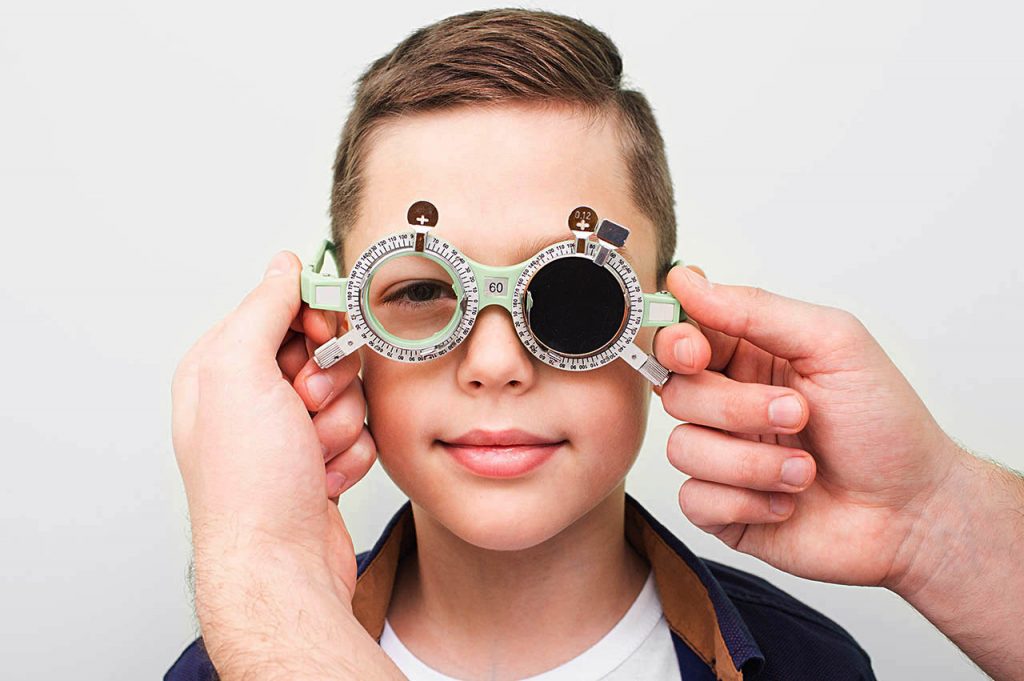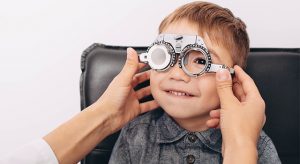Here are answers to the most frequently asked questions about this eye test.
Comprehensive eye exams are key to ensuring that your child has the vision they need for success in school and in life.
But how do eye doctors know that they’re seeing the whole picture and giving your child what they need to succeed?
In a 2015 report entitled The Impact of Myopia and High Myopia, the World Health Organization recommended that children receive a cycloplegic refraction to help eye doctors fully evaluate their vision, detect potential issues early, and ensure accuracy of glasses and contact lens prescriptions.
Not sure what a cycloplegic refraction is? Learn more with our top 5 most frequently asked questions.
Q1: What is refraction?
A refraction is the part of the eye exam that evaluates your eyes for refractive errors, such as nearsightedness, farsightedness, and astigmatism, to determine the extent of those errors, if present.
Your eye doctor will begin the test by using either retinoscopy or an auto-refractor — shining a light into the eyes to observe how the light bends as it travels through the cornea and lens to your retina, at the back of the eye.
This will give them an initial sense of whether there is a refractive error, and a rough estimate of the extent of that error.
Your eye doctor will also conduct a standard refraction, using a trial frame or phoropter head and multiple choices of lenses, to achieve an exact measurement of your optical prescription.
These tests are meant to help your eye doctor evaluate whether you have a refractive error and what optical prescription will be best to correct it.
Q2: What is a cycloplegic refraction?
A cycloplegic refraction is a procedure in which the eye doctor uses eye drops to relax the eye muscles in charge of focusing.
Cycloplegic eye drops will cause your pupils to dilate, and prevent you from over-focusing during your eye exam.
Your eye doctor will have a wider view of the inside of your eyes, making it easier to detect signs of eye disease, such as glaucoma and macular degeneration.
Your eye doctor will also be able to more easily determine the full extent of your vision, without the concern that results may be skewed by inadvertent over-focusing.
Q3: Why is a cycloplegic refraction important during children’s eye exams?
A cycloplegic refraction stops the child from subconsciously over-focusing, allowing the eye doctor to reveal the child’s correct optical prescription and identify early signs of serious eye conditions, such as lazy eye or strabismus.
Children’s eye exams can also be more difficult than adult eye exams for a number of reasons:
- Children often don’t notice when they are having vision issues, so they rarely self-report symptoms.
- Even when children do realize they’re having trouble seeing, they may not necessarily have the verbal skills to communicate exactly what they are experiencing.
- During refraction, children are often concerned with ‘getting a good score’ on the vision test, making them more likely to over-focus subconsciously. This can skew results and hide the full extent of their visual problems.
SEE RELATED: Why Does My Child Need a Cycloplegic Refraction?
Schedule an appointment with an eye doctor to see if your child can benefit from a cycloplegic refraction.
Q4: What happens if the results of my child’s eye exam are wrong?
During eye exams, children may subconsciously over-focus to be able to see better. This may cause the results of refractions and other tests during the eye exam to be inaccurate.
Without a cycloplegic refraction, an eye doctor may accidentally prescribe glasses or contact lenses that do not fully correct the child’s visual problem.
This can cause frustration in all areas of a child’s life, including in school and in extracurricular activities.
In the long-term, inaccurate test results may prevent detection of serious eye problems, such as lazy eye (amblyopia) or eye turns (strabismus).
If these problems remain undetected and untreated, it can ultimately lead to life-long vision issues, including partial or complete blindness in one eye.
Q5: Are there side effects from cycloplegic eye drops?
There are no long-term side effects from cycloplegic eye drops. However, due to the fact that the eye drops cause the focusing muscles to relax, patients will experience blurry near-vision, such as when reading or using a digital device.
The drops may also cause a stinging sensation for the first few minutes, and sensitivity to light until the drops wear off.
Symptoms usually dissipate within 2 to 8 hours, though in some cases, may persist for up to 24 hours.
Your eye doctor will discuss the importance of these drops, what to be aware of, and how to best manage in the hours afterwards.
LEARN MORE: Guide to Children’s Eye Exams
Your child might need a cycloplegic refraction to reveal the most accurate optical prescription and prevent a lazy eye, schedule an appointment with an eye doctor near you.
Not sure why your child needs a cycloplegic refraction?
Learn more with these top 5 most frequently asked questions.









